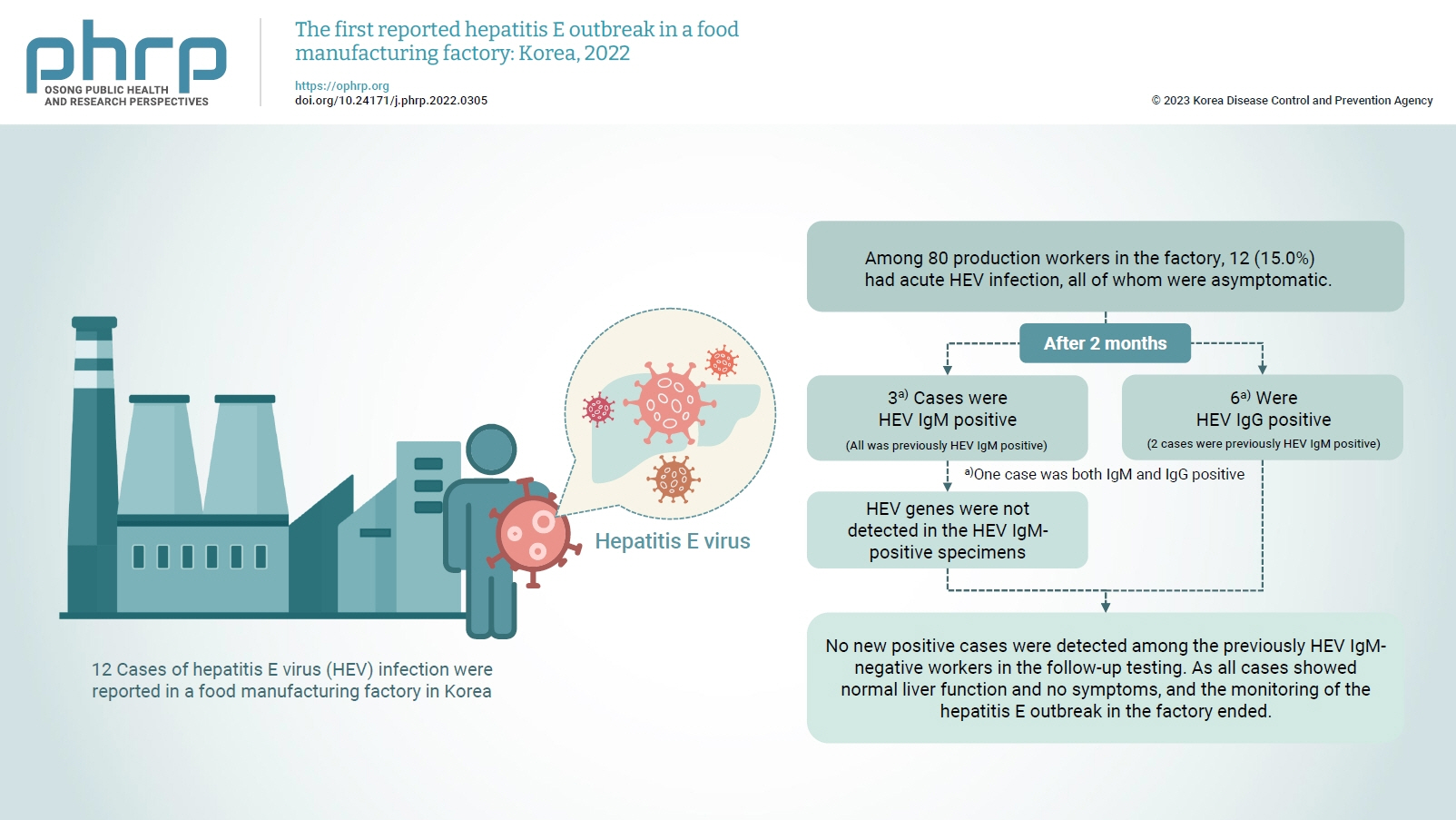Search
- Page Path
- HOME > Search
Original Articles
- The first reported hepatitis E outbreak in a food manufacturing factory: Korea, 2022
- Hansol Yeom, Soonryu Seo, Youngsil Yoon, Jaeeun Lee, Myung-Guk Han, Deog-Yong Lee, Sun-Whan Park, Song A Park, Sook-Hyang Jeong, Jin Gwack
- Osong Public Health Res Perspect. 2023;14(1):15-22. Published online February 22, 2023
- DOI: https://doi.org/10.24171/j.phrp.2022.0305
- 1,663 View
- 139 Download
-
 Graphical Abstract
Graphical Abstract
 Abstract
Abstract
 PDF
PDF 
- Objectives
On February 16, 2022, 12 cases of hepatitis E virus (HEV) infection were reported in a food manufacturing factory in Korea. The aim of this study was to identify additional cases and to determine the source of this HEV outbreak. Methods: This study was an in-depth investigation of 12 HEV immunoglobulin M (IgM)-positive cases and their demographic, clinical, and epidemiological characteristics. On-site specimens were collected from the environment and from humans, and a follow-up investigation was conducted 2 to 3 months after the outbreak. Results: Among 80 production workers in the factory, 12 (15.0%) had acute HEV infection, all of whom were asymptomatic. The follow-up investigation showed that 3 cases were HEV IgMpositive, while 6 were HEV IgG-positive. HEV genes were not detected in the HEV IgM-positive specimens. HEV genes were not detected in the food products or environmental specimens collected on-site. HEV was presumed to be the causative pathogen. However, it could not be confirmed that the source of infection was common consumption inside the factory. Conclusion: This was the first domestic case of an HEV infection outbreak in a food manufacturing factory in Korea. Our results provide information for the future control of outbreaks and for the preparation of measures to prevent domestic outbreaks of HEV infection.
- Seroprevalence of Hepatitis A and E Viruses Based on the Third Korea National Health and Nutrition Survey in Korea
- Haesun Yun, Hyeok-Jin Lee, Doosung Cheon, Chaeshin Chu, Kyung Won Oh, Young Taek Kim, Youngmee Jee
- Osong Public Health Res Perspect. 2011;2(1):46-50. Published online June 30, 2011
- DOI: https://doi.org/10.1016/j.phrp.2011.04.009
- 3,053 View
- 16 Download
- 7 Crossref
-
 Abstract
Abstract
 PDF
PDF - Objectives
The purpose of this study was to investigate the seroprevalence of hepatitis A virus (HAV) and hepatitis E virus (HEV) in Korea during 2005.
Methods
Study subjects were selected from across Korea using a stratified multistage probability sampling design, and HAV and HEV seroprevalence was compared on the basis of sex, age, and residency. A total of 497 rural and urban people aged 10–99 years of age (mean ± SD age = 28.87 ± 17.63 years) were selected by two-stage cluster sampling and tested serologically for anti-HAV and anti-HEV IgG using an enzyme-linked immunosorbent assay.
Results
Among this population, the overall seroprevalence of HAV was 63.80% (55.21% aged in their 20s and 95.92% in their 30s, p < 0.01) and that of HEV was 9.40% (5.21% aged in their 20s and 7.14% in their 30s, p < 0.01). Seroprevalence also varied according to area of residence. HEV prevalence in rural areas was higher than that of urban regions based on the anti-HEV antibody, odds ratio 3.22 (95% confidence interval: 1.46–7.10, p < 0.01). There were no significant differences between male and female against anti-HAV/HEV antibodies.
Conclusion
Our study suggested that the seropositive rates of HAV and HEV might be related to age and environmental conditions. -
Citations
Citations to this article as recorded by- Factors associated with anti-hepatitis A virus immunoglobulin G seropositivity among Korean workers: a cross-sectional study
Eunchan Mun, Yesung Lee, Byungseong Suh, Wonsul Kim, Jinsook Jeong, Hwanjin Park, Woncheol Lee, Boksoon Han, Soyoung Park, Changhwan Lee
BMJ Open.2020; 10(6): e036727. CrossRef - Seroprevalence and risk factors of hepatitis E virus infection among the Korean, Manchu, Mongol, and Han ethnic groups in Eastern and Northeastern China
Yanan Cai, Si-Yuan Qin, Aidong Qian, Peng Xu, Ying-Tian Xu, Lin-Hong Xie, Quan Zhao, Xiao-Xuan Zhang
Journal of Medical Virology.2017; 89(11): 1988. CrossRef - Hepatitis E virus exposure in pregnant women in rural Durango, Mexico
Cosme Alvarado-Esquivel, Luis F. Sánchez-Anguiano, Jesús Hernández-Tinoco
Annals of Hepatology.2014; 13(5): 510. CrossRef - Epidemiologic Study on Hepatitis A Virus Seroprevalence in Busan
Kyung-Soon Cho, So-Hyun Park
Korean Journal of Clinical Laboratory Science.2014; 46(1): 17. CrossRef - A Systematic Review of Hepatitis E Virus Infection in Children
V. P. Verghese, J. L. Robinson
Clinical Infectious Diseases.2014; 59(5): 689. CrossRef - Hepatitis E Virus (HEV) Seroprevalence in the general population of the Republic of Korea in 2007–2009: a nationwide cross-sectional study
Youngsil Yoon, Hye Sook Jeong, Haesun Yun, Hyeokjin Lee, Yoo-Sung Hwang, Bohyun Park, Chae Jin Lee, Sangwon Lee, Ji-Yeon Hyeon
BMC Infectious Diseases.2014;[Epub] CrossRef - The Road Less Traveled
Chaeshin Chu
Osong Public Health and Research Perspectives.2011; 2(1): 1. CrossRef
- Factors associated with anti-hepatitis A virus immunoglobulin G seropositivity among Korean workers: a cross-sectional study



 First
First Prev
Prev


